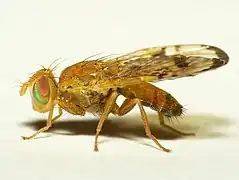| Xyphosia miliaria | |
|---|---|
 | |
| Xyphosia miliaria, female | |
| Scientific classification | |
| Domain: | Eukaryota |
| Kingdom: | Animalia |
| Phylum: | Arthropoda |
| Class: | Insecta |
| Order: | Diptera |
| Family: | Tephritidae |
| Subfamily: | Tephritinae |
| Tribe: | Xyphosiini |
| Genus: | Xyphosia |
| Species: | X. miliaria |
| Binomial name | |
| Xyphosia miliaria | |
| Synonyms | |
Xyphosia miliaria is a species of tephritid or fruit flies in the family Tephritidae.[8]
Distribution
This species is present in most of Europe, in the eastern Palearctic realm, and in the Near East.[9]
Habitat
This species occurs in wet meadows, in parks and gardens with the presence of thistles.[10][11][12]
Description
.JPG.webp)
Xyphosia miliaria may have a body length of 5 to 8 mm and a wingspan of 15 to 18 mm.[11] The thorax and the abdomen are yellowish, sparsely covered with long bristles and the mesonotum is longer than wide. The abdomen is round in males, elongated in the females and the females bear at the end of the abdomen a dark brown, pointed ovipositor. The large compound eyes are orange-red. The wings are decorated with distinctive dark apical and transversal drawings.[10]
Biology
The adults fly from May to September feeding on nectar and pollen of various flowering plants.[11] Larvae develop on buds of thistles (Carduus nutans, Cirsium arvense, Cirsium palustre, Cirsium eriophorum).[10]
Gallery
 Side view
Side view Wing detail
Wing detail- Oviposition (video clip)
- Feeding on thistle (video clip)
Bibliography
- Merz, B. - Faunistics of the Tephritidae of the Iberian Peninsula and the Baleares in Mitt. Schweiz. Entomol. Ges.
- Norrbom, A. L., Carroll, L. E., Thompson, F. C., White, I. M. & Freidberg, A. - Systematic database of names in Thompson, F. C. (Ed.) Fruit Fly Expert System and Systematic Information Database. Myia.
- Seguy, E. - F. Trypetidae in Faune de France. 28. Dipteres (Brachyceres) (Muscidae Acalypterae et Scatophagidae)
- White, I. M. - Tephritid flies (Diptera: Tephritidae) in Handbooks for the Identification of British Insects.10 (ser. 5a)
References
- 1 2 Schrank, F. von Paula (1781). Envmeratio insectorvm Avstriae indigenorum. Augustae Vindelicorum [=Augsburg]: Eberhardi Klett et Franck. pp. xxiv + 548 + [4] pp., 4 pls. Retrieved 27 April 2021.
- ↑ Costa, A. (1854). "Fragmenti di entomologia napoletana". Ann. Sci., Naples. 1: 69–91.
- ↑ Fabricius, J.C. (1781). Species insectorum. Vol. 2. Hamburgi et Kilonii [= Hamburg and Kiel]: C. E. Bohnii. p. 494.
- ↑ Robineau-Desvoidy, André Jean Baptiste (1830). "Essai sur les myodaires". Mémoires presentés à l'Institut des Sciences, Lettres et Arts, par divers savants et lus dans ses assemblées: Sciences, Mathématiques et Physique. 2 (2): 1–813. Retrieved 15 July 2018.
- ↑ Schrank, F. von P. (1803). Favna Boica. Durchgedachte Geschichte der in Baiern einheimischen und zahmen Thiere. Krull, Landshut. pp. viii + 1–372 pp.volume=3.
- ↑ Becker, Theodor (1905). Cyclorrhapha Schizophora: Holometopa. In Becker,T., Bezzi, M., Kertesz, K, & Stein, P. (eds.), Katalog der Palaarktischen Dipteren. Vol. 4. Budapest. pp. [i] +1–328.
{{cite book}}: CS1 maint: location missing publisher (link) - ↑ Drensky, P. (1943). "Die Fliegen der Familie Trypetidae (Dipt.) in Bulgarien". Annuaire de l'Université de Sofia Faculte physico-mathématique. 3: 69–126.
- ↑ Norrbom, A.L.; Carroll, L.E.; Thompson, F.C.; White, I.M; Freidberg, A. (1999). "Systematic Database of Names. Pp. 65-252. In Thompson, F. C. (ed.), Fruit Fly Expert Identification System and Systematic Information Database". Myia. 9: vii + 524.
- ↑ Fauna europaea
- 1 2 3 Insectoid
- 1 2 3 Commanster
- ↑ Korneyev, V.A. (2003). "New and little-known Tephritidae (Diptera, Cyclorrhapha) from Europe" (PDF). Vestnik Zoologii. 37 (3): 3–12, 101. Retrieved 26 April 2021.